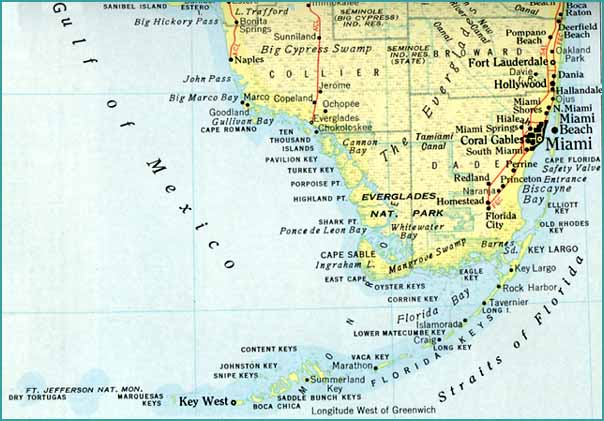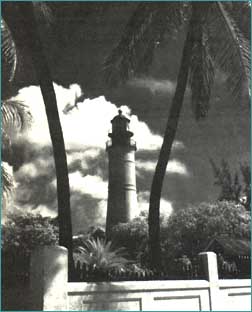
A 1962 map of the southern tip of Florida showing names for the larger Florida Key Islands. (Click for larger view.)
The Florida Keys
by Frank Howard
© May 31, 1995
The "Cayos" or Keys that provide a tail to the map of Florida were known from the early days of discovery. There are over 880 of the islands large enough to appear on maps. On the island of Key West the Spanish explorers had found many human bones. They named the place Cayo Hueso (Bone Island). Later settlers misspoke the Hueso (spoken "wesso") as west and the name became Cay West or Key West.
The route of the fat treasure laden ships of Spain sailing from South America took them to Cuba as their first stop. The shallow waters which stretch for miles along the keys caused many a Spanish ship to come to grief as they left Cuba in route to Spain. Of course this gave rise to two kinds of temporary inhabitants in the keys; "Wreckers", and Pirates!
 |
Wreckers, as they were called, were merely opportunist (at least in the beginning) who lived in the keys during bad weather times. They always kept a sharp lookout for ships who wandered, or were storm-tossed, into the shallows and/or onto coral heads. The lookouts' cry of "wreck ashore" meant good pickings for all who could make it out to the wreck. In good weather times when wrecks were few some residents were known to put up false lights and cause shipwrecks. This was just another form of piracy.
Pirates, of course, hid their small fast shallow draft vessels in among the keys. From such vantage points they could sweep out and quickly subdue the laden ships. They were not opposed to attacking the "wreckers" to drive them from a good wreck. The Spanish were bothered by these "Brethren of The Coast" for the entire 300 years they occupied the area.
The United States would not tolerate them. Only one year after Spain ceded Florida back to the U. S., the Navy was sent in force to remedy the situation. After a few short years of hanging pirates the area was cleared out and Key West became a Naval Base. It is interesting to note that during the Civil War, Key West was the Naval Headquarters for our own area. Ships captured here were most always sent to that base.
"Legitimate" wrecking continued on up to the time the U. S. government established a string of reef lights along the keys. After that it was not as profitable and wreckers took up "birding" and other trades. The then more rare sound of "wreck ashore" still provided early settlers with minor windfalls on into this century. In 1870, Key West was listed as the largest city in Florida. But the only way in or out was by boat.
In the 1880's Commodore R. M. Munroe introduced the Sharpie flat-bottomed working sailboat into the area that was to become Miami. Although it quickly became the Florida Sharpie and gave a boost to the fishing and turtling industries, the keys remained largely isolated until the early 1900's and the advent of the great "Overseas Railroad" built by Henry Flagler.
 The Key West Lighthouse (1960 photo) is one of the few in the United States within the confines of city limits. The light in the stuccoed tower can be seen by approaching ships within fifteen miles of the island. |
The great railroad took 8 years to build and cost a staggering 50 million dollars along with the lives of nearly a thousand workers. Imagined by most to be impossible, it was dubbed "Flagler's Folly" by the public until it was completed. Imagine the logistics of getting food and water to some 4000 men each day in such a desolate place as a string of small islands! It is said the cement for the below water portions of the bridge was so special it had to be imported from Germany.
The first train moved over the entire length in 1912 right after a four year construction period on the longest bridge (7 miles), provided the finishing touch for the railroad. The railroad lasted only 22+ years as it was destroyed in 1935 by the 200 mph winds of a storm.
The rail bed was taken over and rebuilt as a highway. The "Overseas Highway" opened in 1938. In 1942 the Navy laid a pipeline beside it to supply the islands with fresh water. This, and the 7 mile bridge, were rebuilt in 1982 (at a cost of 200 million?).
Of particular note, in 1967 Key West became the first U. S. city to have it's entire fresh water supply supplied from sea water. Desalinization of sea water is presently in use in many parts of the world and may be the answer to Miami's constant water supply problems.
1982 was also the year the "Conch Republic" seceded from the Union. It seems Key West folk were angry at the over-zealous efforts of the Border Patrol to stop drug smugglers. It was harming the Islands main trade: tourism. The secession was treated as a point made and now exists only in jest.
The Historic District of old Key West is preserved as a park administered by the Florida Department of State and is open to the public by either walking through or by "Conch" tours.
